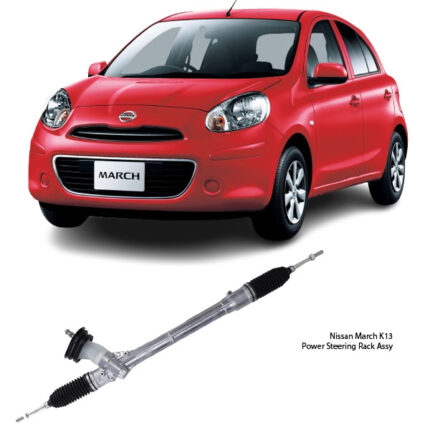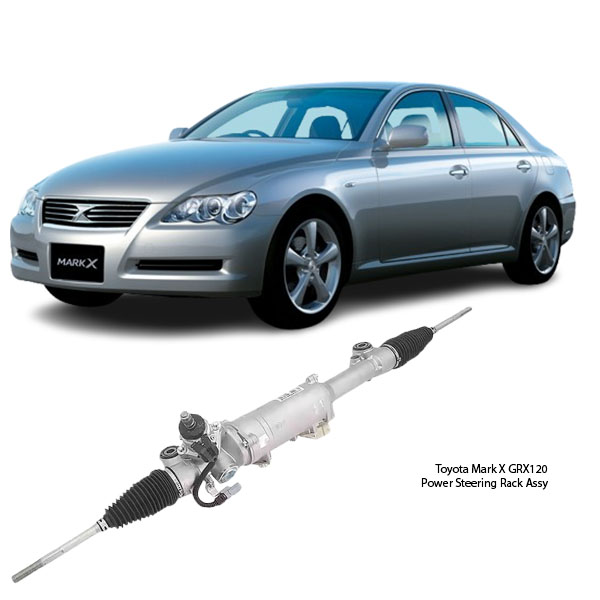Get Toyota Mark X GRX120 EPS Power Steering Rack Assy 44200-30302 in Kenya
The Power Steering Rack Assembly is a critical component in a vehicle’s steering system, especially in modern cars equipped with rack and pinion steering systems. It acts as the central unit that translates the rotational movement of the steering wheel into the lateral movement required to turn the vehicle’s wheels. This process is assisted by hydraulic or electric power to reduce steering effort, providing smoother and more precise handling.
Key Functions of a Power Steering Rack Assembly
-
Steering Control:
When you turn the steering wheel, the steering column transmits this input to the rack assembly. The rack then converts the rotary motion into lateral motion, moving the front wheels left or right. -
Power Assistance:
In hydraulic power steering systems, the rack assembly contains ports and chambers that receive high-pressure fluid from the power steering pump. This fluid pressure assists the driver, significantly reducing the effort required to turn the steering wheel — especially at low speeds or when parking.In electric power steering (EPS) systems, an electric motor attached to the rack provides the assist instead of hydraulic fluid.
-
Load Bearing:
The rack assembly endures significant mechanical stress since it must withstand the combined forces of vehicle weight, road impact, and steering input. Therefore, it must be extremely durable.
Components of a Power Steering Rack Assembly
A complete power steering rack assembly comprises several key parts:
| Component | Function |
|---|---|
| Steering Rack | The main bar that moves left or right to steer the wheels. |
| Pinion Gear | Attached to the steering column; converts wheel rotation into linear motion. |
| Hydraulic Cylinder (for hydraulic systems) | Houses hydraulic fluid that provides steering assist. |
| Rack Housing | The outer casing that protects internal parts from debris and moisture. |
| Tie Rods | Connects each end of the rack to the steering knuckles, moving the wheels directly. |
| Seals & Bushings | Maintain fluid pressure (in hydraulic systems) and reduce friction between parts. |
Types of Power Steering Rack Assemblies
-
Hydraulic Power Steering Rack (HPS)
Uses hydraulic fluid pressure generated by a power steering pump to assist steering. This system is reliable but requires periodic fluid maintenance. -
Electric Power Steering Rack (EPS)
Uses an electric motor to provide steering assist. EPS systems are lighter and more efficient, eliminating the need for a power steering pump or fluid. -
Electro-Hydraulic Power Steering (EHPS)
A hybrid system where an electric motor powers a hydraulic pump. This combines some benefits of both systems, often found in performance or luxury vehicles.
Benefits of a Power Steering Rack Assembly
✅ Easier Steering:
Whether using hydraulic assist or electric assist, the system greatly reduces the physical effort needed to steer the vehicle — especially at low speeds.
✅ Precision Handling:
The rack and pinion design provides direct and predictable steering feedback, making the vehicle easier to control at high speeds.
✅ Compact Design:
Compared to older recirculating ball steering systems, rack and pinion assemblies are smaller, lighter, and simpler to install.
✅ Versatility:
Suitable for everything from compact cars to SUVs and light trucks. Modern systems are designed to accommodate varying vehicle weights and handling characteristics.
Common Signs of Power Steering Rack Failure
🔴 Steering Wheel Play:
Excessive free play or looseness in the steering wheel often indicates worn gears or tie rods within the rack assembly.
🔴 Hard Steering:
Increased steering effort can mean the power assist (hydraulic or electric) is failing. In hydraulic systems, low fluid levels or leaks could be to blame.
🔴 Fluid Leaks:
Puddles of power steering fluid (typically reddish or amber) under the car may indicate worn seals or a crack in the housing.
🔴 Noisy Steering:
A clunking, grinding, or knocking noise when turning the wheel can point to worn internal parts, loose tie rods, or contaminated fluid.
🔴 Uneven Tire Wear:
A failing rack can affect wheel alignment, causing irregular tire wear even after an alignment is performed.
🔴 Steering Drift:
If the car pulls to one side or doesn’t return to center after a turn, the rack may be binding or internally damaged.
Causes of Power Steering Rack Failure
🚨 Contaminated Fluid:
In hydraulic systems, dirty or degraded fluid can cause internal wear and clogged ports, leading to steering stiffness or poor assist.
🚨 Wear and Tear:
Over time, normal use causes internal gears, seals, and bushings to wear out — especially if driving on rough roads or under heavy loads.
🚨 Leaks:
Fluid leaks (in hydraulic systems) reduce assist and expose internal components to air and moisture, accelerating corrosion.
🚨 Impact Damage:
Hitting curbs, potholes, or debris can bend tie rods or damage the rack housing, leading to steering instability.
Maintenance Tips for Power Steering Rack Assemblies
✔️ Regular Fluid Checks (for Hydraulic Systems):
Check the power steering fluid level and condition regularly. Low or dirty fluid can accelerate wear and cause premature failure.
✔️ Flush Power Steering Fluid Periodically:
Over time, fluid degrades due to heat and contamination. Follow the manufacturer’s service schedule to flush and replace the fluid.
✔️ Inspect for Leaks:
Check the rack, hoses, and fittings for leaks during regular service inspections.
✔️ Check Tie Rods:
Tie rods connect the rack to the wheels, so worn tie rod ends can cause steering play and uneven tire wear. Replace as needed.
✔️ Avoid Excessive Force:
Avoid holding the steering wheel at full lock for extended periods — this stresses the pump and rack components unnecessarily.
✔️ Wheel Alignment:
After replacing the steering rack or tie rods, always perform a proper wheel alignment to avoid steering drift and tire wear.
Replacement Considerations
When replacing a power steering rack assembly, always choose quality parts from reputable brands. Cheap or poorly rebuilt racks often fail prematurely and can compromise safety. Original Equipment (OE) parts or high-quality aftermarket brands like KYB, TRW, ZF, or NSK are recommended.
Also, replacing the rack is a labor-intensive job that typically requires removing suspension components, subframes, or exhaust parts — meaning it’s best handled by experienced technicians.
Conclusion
The Power Steering Rack Assembly is a vital component ensuring safe, responsive, and effortless steering. Its design — whether hydraulic or electric — allows drivers to easily maneuver vehicles while maintaining road feel and control. Proper maintenance, including fluid checks, leak inspections, and tie rod monitoring, extends the life of this critical part.
If you notice warning signs like heavy steering, leaks, or odd noises, prompt diagnosis and repair are crucial to avoid costly damage and ensure your vehicle remains safe to drive. Whether you drive a compact car, SUV, or performance vehicle, keeping your steering rack in top condition ensures confident and precise handling every time you get behind the wheel.
Follow us on Facebook for more parts.




Reviews
Clear filtersThere are no reviews yet.